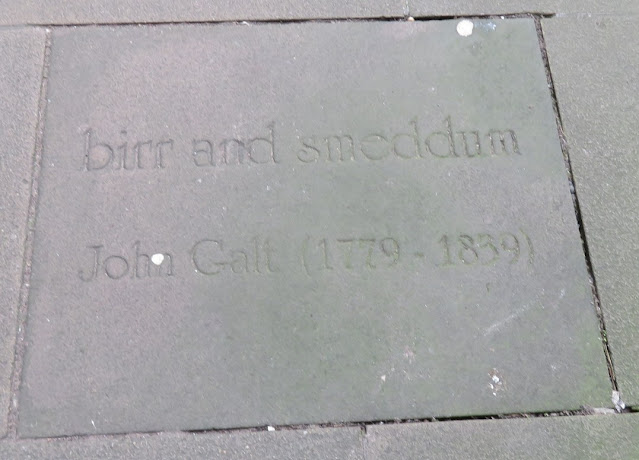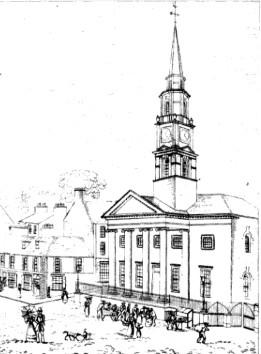It is difficult to imagine now, but the Bardrainney area of Port Glasgow was once quiet countryside with Bardrainney House and a surrounding estate of small farms. The surrounding land belonged to James Cunningham, 14th Earl of Glencairn. Alexander Dalziel living at Bardrainney was his factor, dealing with the efficient running of the Estate of Finlaystone.
any of the local farms were let out and as this newspaper clipping from 1789 shows, some of the names may be recognisable - Bogside, Knockmountain, High Langside, Laigh Langside, Laigh Castlehill, Bardrainnies and Parklee.

Alexander Dalziel was born in West Linton, the son of George Dalziel who was thought to have been an innkeeper at West Linton and Noble-house Inn. He also owned farming land in the area. (He certainly seems to know how to attract clients!)
It was reported that George Dalziel “was the first farmer that
sewed turnip in open fields; I believe
he had a field of perhaps two or three acres at Linton, so early as 1763 or
1764. I believe he might also be the
first who cultivated potatoes on a large scale, by the plough”. (History of
Peeblesshire, William Chambers, 1864.)
Alexander Dalziel had (at least) two sisters, Margaret, and Mary who
married James Craig, a mason in Penicuik.
 |
| Earl of Glencairn |
As factor to the Earl of Glencairn, Alexander Dalziel would have often had to travel to Edinburgh on the Earl's business and it is here that he is thought to have met the poet, Robert Burns. They both admired the work of Edinburgh poet Robert Fergusson (1750-1774). Dalziel is said to have been responsible for introducing Burns' poetry to the Earl of Glencairn who became a valued patron of the poet.
“My Dear Sir, I have taken the liberty to frank this letter
to you, as it encloses an idle poem of mine, which I send you; and, God knows,
you may perhaps pay dear enough for it if you read it through. Not that this is my own opinion but the
author, by the time he has composed and corrected his work, has quite pored
away all his powers of critical discrimination.
I can easily guess from my own heart, what you have felt on
a late most melancholy event. God knows
what I have suffered, at the loss of my best friend, my first and dearest
patron and benefactor; the man to whom I owe all that I am and have! I am gone into mourning for him, and with
more sincerity of grief than I fear some will, who by nature’s ties ought to
feel on the occasion.
I will be exceedingly obliged to you indeed, to let me know
the news of the noble family, how the poor mother and the two sisters support
their loss. I had a packet of poetic
bagatelles ready to send to Lady Betty, when I saw the fatal tidings in the
newspaper. I see by the same channel
that the honoured remains of my noble patron are designed to be brought to the
family burial place. Dare I trouble you
to let me know privately before the day of interment, that I may cross the
country, and steal among the crowd, to pay a tear to the last sight of my ever
revered benefactor? It will oblige me
beyond expression."
"Alexander Dalziel, Esq of West Linton, formerly of Port
Glasgow. Mr Dalziel was the intimate
friend of the Scottish poets, Fergusson and Burns; of the former he was
accustomed to relate many interesting anecdotes, and, of the latter, he was
fortunate enough to be the early patron, by introducing him to the Earl of
Glencairn, an event which Burns never recollected but with the enthusiasm of
grateful feeling. Mr Dalziel is styled
by an excellent judge, the elegant biographer of our immortal bard, one of the
ablest of his correspondents. No man was
more remarkable for acuteness and accuracy in business, for a sturdy
independence of mind, and for keen indignation at any appearance of falsehood,
dishonesty and meanness.”
Alexander Dalziel seems to have been a very interesting character and is thought to have been an early member of Greenock Burns Club along with fellow Port Glasgow resident and friend of Burns, Richard Brown.






.JPG)
.JPG)
.JPG)
.JPG)
.JPG)




.JPG)









.JPG)

.JPG)
.JPG)
.JPG)
.JPG)
.JPG)
.JPG)
.JPG)
.JPG)









.JPG)



